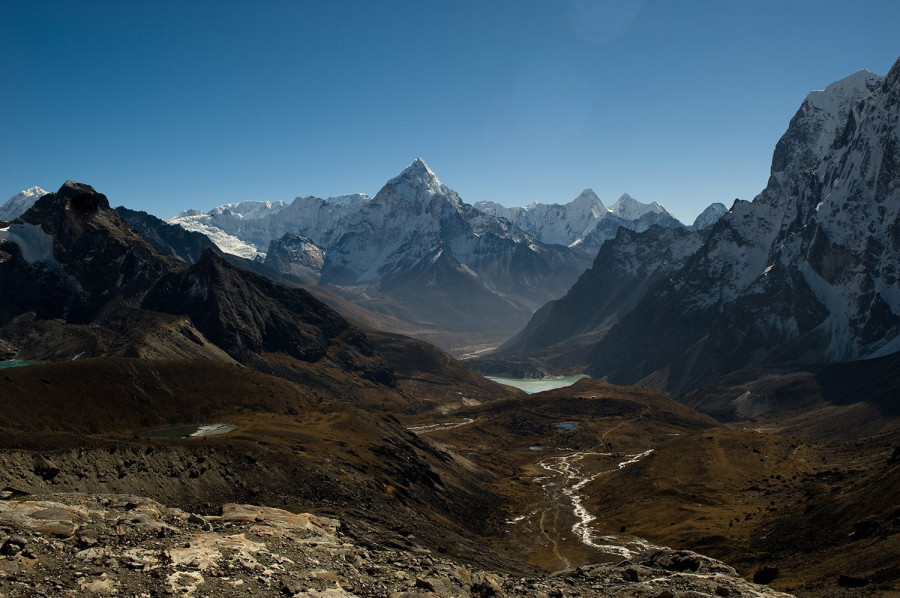Columns
Climate services for a resilient Everest economy
As risks grow for mountaineering, tourism stakeholders must act urgently to build the region’s resilience.
Anu Kumari Lama & Tenzing Chogyal Sherpa
This year marks the 70th anniversary of the first successful ascent of Everest, the world’s highest mountain. As of April 2023, 396 individuals received permits to climb Everest this climbing season. In the last three decades, the total number of summiteers has reached around 6,978.
This tremendous growth in the number of climbers, which surpassed only six people summiting Everest in 1965, is due to the commercialisation of mountaineering and the explosive growth in expeditions in the region. Given that mountains are hotspots for climate change impacts, the environmental and socioeconomic risks are growing for the mountaineering community and expeditions. Climate services—providing climate information, data and tools to support decision-making and planning—are essential for supporting mountain communities, tourism enterprises and tourists. These services form the backbone of a resilient Everest economy in the face of increased climate extremes.
The installation of weather stations on Everest has been a game changer in providing vital climate services. These services provide weather forecasting to ensure early warning and preparedness and thereby foster safe and successful expeditions. They also facilitate rescue operations. Taking informed action in response to weather and climate extremes is imperative in making the Everest expedition economy safe, secure and sustainable.
Economics of expeditions
Everest expeditions today are a major economic source for the Nepal government as well as associated private sectors and local communities. The Everest expedition economy generates multiple co-benefits to various supply chain actors, including the Department of Tourism (permit and liaison office), expedition companies (those based inside and outside of Nepal) and expedition support staff (climbing Sherpas, expedition guides and cooks).
This year, Everest has already generated a revenue of around $4.2 million through sales of climbing permits. There are over 1,500 companies registered with the Nepal Mountaineering Association; of these, 25-30 provide regular expedition services. Each company charges around $35,000 per client for an expedition package. Foreign-based companies account for 25 percent of the expedition market share and charge around $100,000 per client for their expedition packages.
Currently, roughly 90 percent of the Everest climbers are guided clients. For an expedition comprising 15 climbers, a supply chain comprising 109 members are deployed as support staff.
A changing climate
The Everest region is experiencing rising temperatures. Glaciers surrounding the mountain are thinning, and the region is losing ice at an accelerated pace. Increased incidences of avalanches and landslides have endangered mountaineering communities.
Hazards such as avalanches and falling ice represent the largest category of deaths on Everest. Avalanches form one of the major causes of fatalities, with Everest reporting around 27 percent. They are also attributed to 66 percent of all deaths that occurred between 1953 and 2016 in the Everest region, Khumbu, and its eponymous glacier. Similarly, changing weather is reported as one of the major causes for the increased death toll of climbers in the “death zone”.
The economic costs of increased disasters are also enormous. While 16 lives were lost to the 2014 avalanche in the Khumbu icefall, the shutdown of the remainder of the climbing season in its aftermath also took a toll on those who depended on the climbing season for their earnings. Increasingly, poor weather is resulting in expedition failures. While this has immediate negative impacts (psychologically and economically), the weather may also deter climbers from attempting to summit Everest in the future. This will have grave economic consequences.
Climate services
Climate services encompass data collection, analysis, modelling and dissemination of climate information. Weather and climate information are an essential service in mountaineering. They help avert, minimise and address loss and damage and make mountaineering expeditions, communities and economies more resilient.
Automated Weather Station (AWS) networks installed on the slopes of Everest are delivering important climate services, including weather forecasting, real-time weather information and data on the mountain’s atmospheric conditions. These services enable expedition teams to make informed decisions about their ascent, enhance awareness about weather hazards, and interpret and use information for safe and successful expeditions.
Conducting efficient and effective rescue operations is another important use of such services. Furthermore, low-bandwidth web portals designed for expedition climbers are providing all the crucial parameters for real-time weather conditions. As the network continues to expand, the scope of its benefits will continue to grow, and it will undoubtedly prove to be a vital tool for climbers and rescue teams in the years to come.
Resilient Everest economy
Climate services effectively address the risks of climate change impacts on the mountaineering community (climbers and supply chain actors) and economy from various angles, as they typically involve collaboration between meteorological agencies, climate scientists, policymakers and other stakeholders. As the risks continue to grow for the mountaineering community and expeditions on Everest, tourism stakeholders must act urgently to build the region’s resilience.
Greater access to improved climate services is vital for the mountaineering community and expedition economy. To that end, there is an urgent need to improve and scale up climate services on Everest and across the Hindu Kush Himalaya. We call on international research, funding and mountaineering communities to invest in climate services for more resilient lives and a sustainable economy across the region.




 11.12°C Kathmandu
11.12°C Kathmandu
















